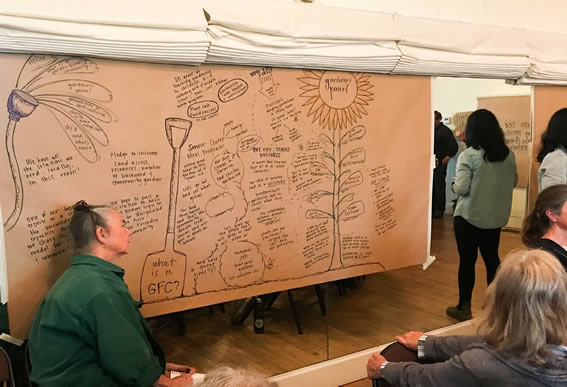Fort Bragg, CA, Pursues Food
Security with Victory Gardens
by Matt Drewno: Excerpt from Word of Mouth Magazine Article
Read the full article at bit.ly/WordofMouthVictoryGardens

IMAGE CREDIT: Word of Mouth Magazine/Victory Gardens for Peace
The following is an excerpt of an article about
VGFP's "Garden-Friendly Community Initiative",
published in Word of Mouth Magazine in 2020.
Twenty-six percent of the children in Mendocino County experienced food insecurity in 2019. In that same year, one out of every four people in Fort Bragg utilized the food bank, and the Ukiah food bank reported a 23% increase in usage. Mendocino County has around 88,000 mouths to feed three times each day—that’s 264,000 meals daily! Locally, we struggle to make sure everyone has access to food, and the pandemic has only increased these challenges. You may be surprised to learn that only about 1-3% of the food grown in Mendocino County stays in Mendocino County. How will this pandemic and the economic hurdles to come impact our food security, and how can we, as individuals, become more resilient in these challenging times?
With COVID-19 shutting down the global and local economies—and with the beauty and vitality of spring in full bloom—what better time to start a garden! Gardens improve nutrition, ease depression, fortify immune systems, enhance education, reduce incidences of violence, and bring a sense of wholeness, peace, and beauty into our lives. They remind us that we are all connected and that a beautiful and abundant future lies right in our backyards.
Throughout history, during times of peace and war, gardening has kept us strong and nourished. During World War I and World War II, the United States government enacted a series of policies aimed at reducing our resource consumption while increasing production to meet the demands of war. Many of our farmers were sent overseas to fight, and our citizens and troops needed to be fed. “Victory Gardens” were promoted as a way to meet the demands of war and increase food security during times of scarcity, because there is no form of agriculture more direct, efficient, and sustainable.
This mass mobilization for the war efforts engaged all industries and communities. Trains and buses previously used for transporting food were shipped abroad to move soldiers, and so Victory Gardens became an important component of localization. Public parks were opened to community gardens, and people began growing food everywhere—on rooftops, in window boxes and backyards. School gardens sprang up to provide food for lunch programs, government agencies printed recipe booklets, and food preservation pamphlets encouraged people to eat less meat. Victory Gardens not only increased our food security during these times, but they also gave citizens a sense of pride in acting as a part of the solution. Gardening made them realize they could do something to help... read more at Word of Mouth.
top | Newsletter Home |Table of Contents| Archive

|



